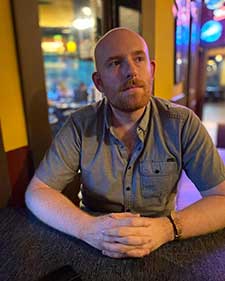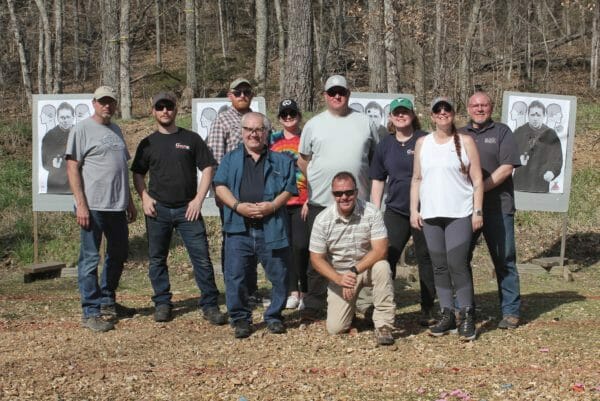
U.S.A. –-(AmmoLand.com)- John Murphy of FPF Training provides a holistic approach to personal defense, covering a wide variety of skills. How does the course compare to other training I’ve taken?
Location
Class was held at Armed Missouri, located in Bland, Missouri, roughly 30 minutes east of Jefferson City. I first trained here in 2018, taking Shivworks’ ECQC, and taught my own Less Lethal class here just a month prior to Street Encounters.
Weather
Weather was fair for April in Missouri. Mornings started a little chilly, with the afternoon warming up. We had constant sun, and mild to strong wind that occasionally knocked targets over.
Equipment
I ran this course with fairly bare-bones equipment. The gun was a gen4 Glock 19, featuring a Kagwerks slide release, Steiner MPS optic mounted on a Forward Controls Design plate, and a KKM threaded barrel with their compensator. This was carried in my KSG Armory Halcyon AIWB holster throughout the class. Spare magazines were carried in pockets and were OEM 15 and 17 round mags.
John Murphy provided us with inert POM pepper spray for use in class, which was simply clipped to the front pocket of my jeans.
Personnel
We had nine students in class, including three women, with the youngest shooter being in their mid 20’s. Backgrounds ranged from former law enforcement and military to truck drivers, teachers, and more. Many were fairly inexperienced, with a few students having solid training backgrounds.
Student Equipment
Most students used a variety of Glocks during class to include the G48, G43X, and my G19. Two CZ P-10C’s were the most exotic guns on the firing line. Three shooters were using optics, which were the Holosun 407K and 507C, and my Steiner MPS.
Prior to Class
Before arriving to class, John Murphy asks students to review a playlist of videos on the FPF Training Youtube channel. These videos span roughly five hours of playtime, and are primarily narrated by John. Situations include a variety of shootings and other violent encounters, various techniques for employing tools, explanations of mental processes, and more.
The purpose of reviewing these videos is to avoid the necessity of a third day of training. I watched these over the course of several weeks, as they’re publicly available, regardless of whether you take the class or not. John speaks to these videos in class, so having them fresh in your mind will help later down the line.
Even if you’re not planning on taking Street Encounters anytime soon, I recommend checking out the FPF Training YouTube channel for some solid learning.
Day One of FPF Training Street Encounters
Classroom Academics
Class starts fairly straightforwardly with a safety briefing and specific rules of engagement for the weekend. From here, we jump directly into indicators of impending violence, being able to recognize things before they happen. Next, we discuss medical equipment and its proper use, with John giving us our own ankle medical kits for use throughout the weekend, which include a CAT tourniquet and an Israeli bandage.
Once we are instructed on their proper use and get a few chances to practice, John informs us that throughout the weekend, he will randomly give commands to remedy certain wounds, allowing us to practice with our equipment under pressure. I won’t annotate how often this occurs in class, but we get roughly a dozen chances to save ourselves over the weekend.
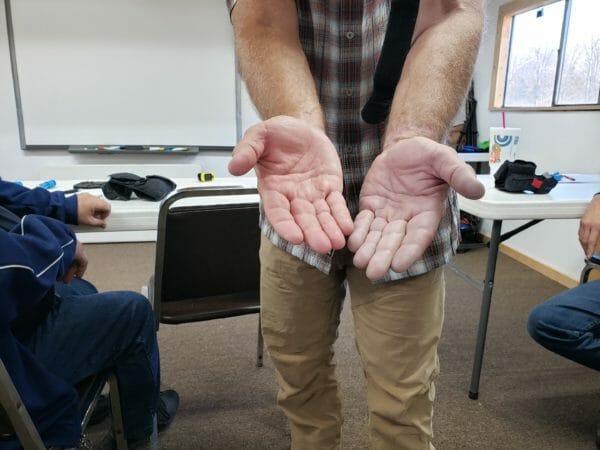
Our next subject is less lethal tools, with a focus on pepper spray, or OC. We cover placement on our body, the effects of OC, the draw stroke and employment, and more. John provides each student with two inert training sprays and a live spray which are ours to take home, supplied by POM. After the less-lethal academics, we head outside for some practical application.
Range Time
While outside, John has us doff our pistols and other tools to ensure we have a sanitized environment for some scenario-based training. We begin with John demonstrating the effects of wind and range on our OC sprays. From here we learn about intelligent defensive movement, incorporating obstacles and arcing movement, as well as appropriate use of verbal commands. Using our inert OC, John acts as an aggressor for students to practice these techniques under stress, giving a preview of what is to come later in the course.
After this, we head back into the classroom for more academics.
More Classroom Time
We return to the classroom and immediately jump into a lecture about interaction with law enforcement. We discuss how and when to call 911, intelligent verbals for the call, and what to do upon arrival of law enforcement on the scene of our defensive encounter.
Next, we cover John Murphy’s Street Encounter Principles. These include understanding the environments we find ourselves in, knowing the capabilities of ourselves and those we surround ourselves with, establishing plans, enforcing boundaries, and more. All of this aligns to help us be successful in an encounter, eliminating as many unknowns as possible ahead of time.

This returns us to the topic of law enforcement interaction, with the focus of post-incident actions. We must provide security for ourselves, establish the active dynamic of the incident with responders, and ensure we do not get confused for the threat by law enforcement. Once we wrap up this discussion, we head to the range for more training.
More Range Time
We arrive on the range and immediately clear our guns. No live ammunition will be fired today, but we perform a significant amount of dry practice, pairing it with inert tools to work all of our skills learned thus far. This starts with working on our concealment draws, establishing proper grips, and other fundamentals. With our inert guns we begin incorporating verbal commands, micro ranging drills, and adding in scenario-based training.
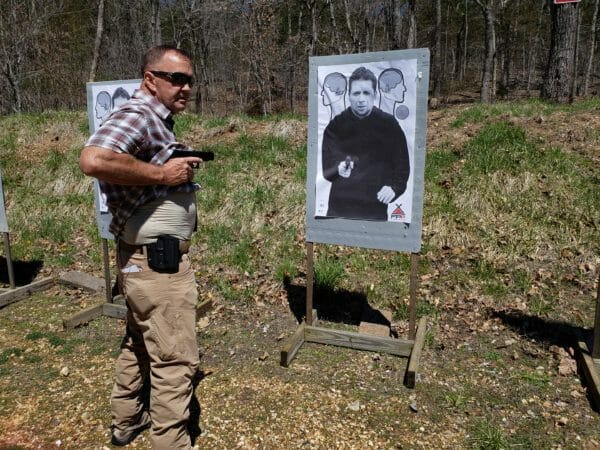
These scenarios test our mettle and help us prepare for a variety of situations we may face in the real world. Scenarios range from being completely benevolent encounters to requiring less-lethal tools and all the way to lethal force. As part of this, John incorporates post-incident actions, simulating witnesses, phone calls to 911, LE response, and more. Each student gets at least one run at a scenario before we wrap for the day.
Day Two of FPF Training Street Encounters
Day two of Street Encounters starts on the range. We’ll remain here all day.
Range Time
The day starts with a safety and medical briefing. Medical procedures are reinforced, as today we’ll be live firing our pistols, and the relatively remote location of the range necessitates a more coordinated response in the event of an emergency. Luckily the plan never has to be put into action.
Academics start with an explanation of the use of force. Specifically, we discuss requirements for lethal force, paired with the different types of stops obtained by various responses. Live fire starts immediately afterward, with a quick assessment, firing five rounds at five yards on three-inch circles. John uses this as an opportunity to diagnose problems in our technique before we incorporate additional layers of stress throughout the day.

The majority of our range time lives at either 3, 5, or 7 yards, typically progressing in that order as we learn new skills throughout the day. John uses a variety of drills incorporating verbal commands, stoppage clearance, visual cues and more. Before lunch, my draw to the first shot is hovering between 1.25 and 1.50 seconds from appendix concealment with a visual cue. This is the first class I’ve taken where we use lasers to prompt instead of rotating targets or an audible cue like a timer or command. I’m a fan of the technique and plan on incorporating it into my own instruction in the future.
We break for lunch and begin setting up the range for the afternoon session of training.
Afternoon Range Time
We return from lunch and begin working on the incorporation of movement. This is to break our attacker’s OODA loop, buying us more time to mount an effective defense. Movement is combined with varying our ready position for some pseudo shoot off’s with partners for several repetitions to add mild stress to our training.
Next, we meet Rupert. Rupert is John’s 3D dummy target, providing us with 360-degree anatomy visualization. John throws a plain T-Shirt on Rupert and outlines an acceptable target area wrapping around his body. We then have the opportunity to shoot Rupert, providing us a clear sight picture of what is appropriate from positions other than the typical straight-on you get with paper targets. Once finished with Rupert (for the moment), we work more flat range drills, incorporating task saturation, modified failure drills, and more.
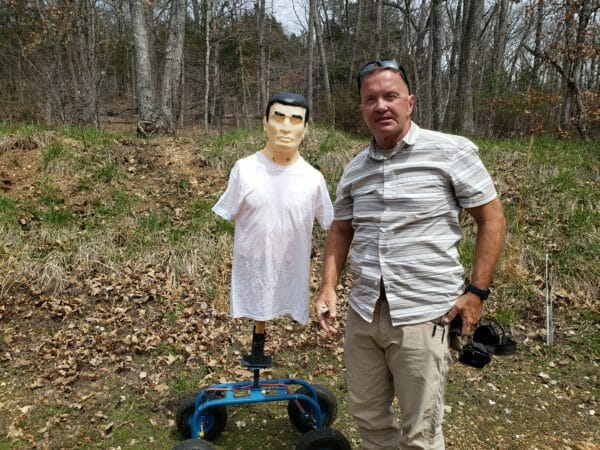
Rupert the Ringer
From here, Rupert makes a strong return, this time with his own transportation. John rigs up an intricate series of pulleys, allowing Rupert to move not only laterally but also forward and back. This is an opportunity to use all of our skills thus far, with John providing verbals for Rupert while others work the pulleys at his direction.
Individually we interact with the now mobile Rupert, going to our pepper spray or pistols as needed. Many students lock up once Rupert is charging them, others make some less than ideal decisions at the moment, and a few repeat those suboptimal decisions intentionally. It’s a great learning opportunity for many people and one of the most unique things I’ve seen to date.
After a few reps with Rupert, we return to more traditional drills with visual stimuli. One of the bigger points that John hammers home is that just because we’ve taken our pistol out, doesn’t mean that it has to be fired. We reinforce this with partners simulating a surrendering attacker, forcing the defender to respond appropriately–not shooting. We use this technique intermittently throughout the remainder of class, ensuring we don’t build negative habits by exclusively shooting every time the gun is presented.
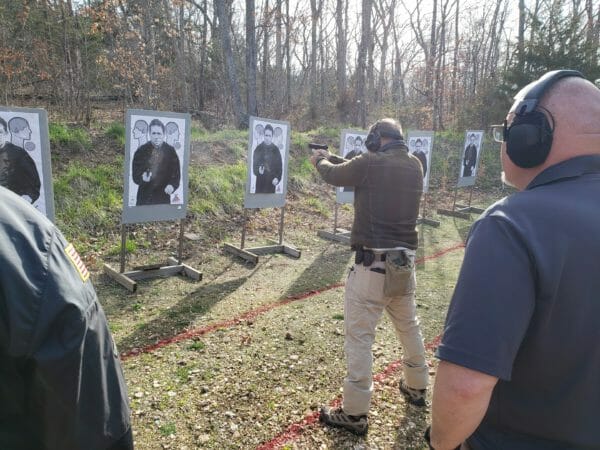
Our final shots in class are a confidence builder. John tells us to choose whatever skill we want to work on, whether that be slow fire into circles or something else. Making sure that these shots count, building our fundamentals back up after a long day of training. From here we debrief, clean up the range, and begin to head our separate ways.
Final Thoughts on FPF Training Street Encounters
Street Encounters by FPF Training is a stellar class. It is the only training I’ve taken that incorporates not only shooting and medical skills but also less-lethal use of force, and legal perspectives, making for an incredibly well-rounded experience. Street Encounters won’t make you an expert in any one field, but the depth of knowledge John provides rivals most other dedicated courses.
I can say without hesitation that if you only have the budget, time, or desire to take one class, this should be the one. Even if you make a regular habit of training, it would be a disservice to yourself not to jump into a class with John Murphy. I know I’ll be making a return.
You can find John Murphy and FPF Training on their website >>HERE<<
About Dan Reedy
Dan is an Air Force veteran, avid shooter, and dog dad. With a passion for teaching, he holds instructor certifications from Rangemaster, Agile Training & Consulting, and the NRA. He has trained with Darryl Bolke, Mike Pannone, Craig Douglas, among several other instructors, amassing over 400 hours of professional instruction thus far. In his spare time you’ll find him teaching handgun, shotgun, and less lethal classes.
Dan’s work has been published by Primer Peak, and The Kommando Blog, and he has been featured as a guest on Primary & Secondary.